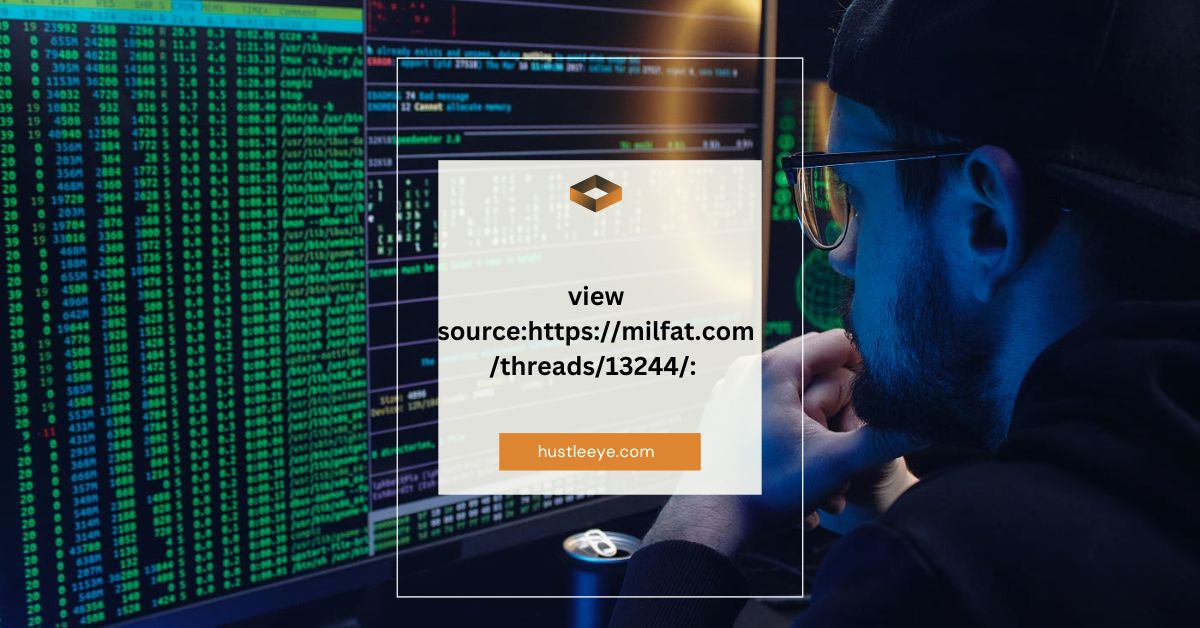In today’s interconnected world, the ability to delve into the underlying code of websites is a crucial skill for developers, designers, and curious users alike. One useful feature in web browsers for exploring this aspect is the “view-source” function. This article provides a detailed examination of how to use this feature with the specific URL :view-source:https://milfat.com/threads/13244/. We will explore the significance of this URL, dissect the components of the source code, and understand why this knowledge is beneficial.
Table of Contents
Introduction:
The “view-source” function is a powerful tool in web browsers that reveals the raw HTML, CSS, and JavaScript code of a webpage. By appending view-source: before a URL, users can access the page’s underlying code rather than its rendered content. This can be particularly illuminating when examining a specific URL, such as :view-source:https://milfat.com/threads/13244/. This guide aims to break down the meaning of this URL, explain how to use the view-source function, and discuss the importance of understanding webpage source code.
Read More: The Complete Guide to Dagesteron: Unveiling Its Potential in Modern Medicine
What is the View-Source Function?
The “view-source” feature is integrated into most modern web browsers, providing a way to view the source code of a webpage. When you prepend view-source: to a URL and enter it into your browser’s address bar, you are presented with a plain text version of the page’s HTML, CSS, and JavaScript code. This can be invaluable for:
- Learning and Education: Observing how HTML, CSS, and JavaScript are used on a well-designed page.
- Troubleshooting: Identifying and fixing issues with your own web development projects.
- Web Design Inspiration: Gaining ideas on layout and functionality from other sites.
- Security and Privacy: Detecting potential vulnerabilities or privacy concerns.
Read More: Chatterbait Social Media: The Ultimate Guide for 2024
Understanding the URL: :view-source:https://milfat.com/threads/13244/
The URL :view-source:https://milfat.com/threads/13244/ directs your browser to display the source code of a specific thread on the milfat.com website. This thread, identified by the number 13244, could contain various forms of content, including discussions, comments, and multimedia elements. Analyzing this source code can provide insights into the thread’s structure, styling, and interactive elements.
1. Breaking Down the URL:
- :view-source:: This prefix instructs the browser to show the source code of the webpage.
- https://milfat.com/: This is the domain of the website.
- threads/13244/: This path specifies a particular thread or discussion on the site.
By viewing the source of this thread, you can explore how the page is built from a coding perspective.
Read More: Bertėjas: A Comprehensive Overview of Revolutionary Translation Technology
Why is Viewing Source Code Important?
1. Learning and Education:
For aspiring developers and designers, inspecting the source code of established pages can serve as a valuable educational tool. By studying how experienced developers structure their code, you can learn about best practices and advanced techniques in web development.
2. Troubleshooting:
If you’re encountering issues with your own website, viewing the source code of similar or well-functioning sites can help identify potential problems. For example, you might spot errors in the HTML structure or issues with JavaScript functionality that can guide you in fixing your own site.
3. Web Design Inspiration:
Web designers often seek inspiration from other sites to enhance their own designs. By examining the source code, you can uncover how certain visual effects, layouts, or user interactions are implemented.
4. Security and Privacy
Understanding the source code can also reveal security flaws or privacy issues. For instance, you might find scripts that track user behavior without consent or other elements that could potentially compromise user data.
Read More: Understanding ỏganic: A Comprehensive Guide to Organic Living
Analyzing the Source Code of :view-source:https://milfat.com/threads/13244/
1. HTML Structure:
When you inspect the source code of :view-source:https://milfat.com/threads/13244/, the first thing you will encounter is the HTML structure. HTML (HyperText Markup Language) forms the backbone of any webpage. Key components include:
- Doctype Declaration: Indicates the version of HTML used.
- Head Section: Contains metadata such as the page title, links to stylesheets, and scripts.
- Body Section: Includes the actual content of the page, such as text, images, and other media.
In the context of this thread, the body section will display the content of the discussion, including user posts and comments.
2. CSS Styles:
CSS (Cascading Style Sheets) controls the visual appearance of the webpage. The source code will reveal how CSS is applied to style the thread on milfat.com, including:
- Layout: Arrangement of elements on the page.
- Fonts: Text styles and sizes.
- Colors: The color scheme of various elements.
- Spacing: Margins, padding, and other spacing attributes.
3. JavaScript Functions:
JavaScript adds interactivity to a webpage. In the source code of :view-source:https://milfat.com/threads/13244/, you may find JavaScript that:
- Handles User Interactions: Functions that respond to user actions like clicking buttons or submitting forms.
- Manages Dynamic Content: Scripts that load content dynamically without refreshing the page.
Read More: iLikeCPMix: A Comprehensive Guide to Transforming Your Digital Marketing Strategy
Exploring Related Terms and Concepts:
1. HTTP vs. HTTPS:
The URL uses HTTPS (HyperText Transfer Protocol Secure), which encrypts data exchanged between your browser and the website. Understanding HTTPS is crucial for recognizing the security of a webpage.
2. URL Parameters:
Although :view-source:https://milfat.com/threads/13244/ does not include parameters, many URLs do. Parameters, often introduced by a question mark (?), pass additional information to the webpage, such as search queries or user preferences. Inspecting the source code can show how these parameters are utilized.
3. HTML5 and Modern Web Design:
Modern websites often use HTML5, which introduces new elements and attributes for creating complex and multimedia-rich webpages. When viewing the source code, you may encounter HTML5 elements like <header>, <footer>, <article>, and <section>.
Read More: Understanding “Kääntäbä”: A Symbol of Cultural Unity and Diversity
Practical Applications of Viewing Source Code:
1. For Web Developers:
Developers use the view-source feature regularly for debugging, learning, and reverse-engineering features. It provides a way to see how certain functionalities are implemented and how to troubleshoot issues.
2. For Marketers:
Digital marketers may analyze the source code to understand SEO practices. By examining the implementation of meta tags, title tags, and header tags, they can glean insights into effective SEO strategies.
3. For Cybersecurity Enthusiasts:
Cybersecurity experts use source code analysis to identify vulnerabilities and assess how data is handled and exposed. Understanding the code can help in recognizing potential security risks.
Read More: Pethardas com: The Ultimate Guide to Unlocking Its Full Potential
How to Use View-Source in Different Browsers:
1. Google Chrome:
- Open Chrome and navigate to the desired webpage.
- Right-click on the page and select “View Page Source,” or type view-source: before the URL in the address bar.
- Review the code displayed in the new tab.
2. Mozilla Firefox:
- Open Firefox and visit the webpage.
- Right-click and select “View Page Source,” or type view-source: before the URL.
- Explore the source code.
3. Microsoft Edge:
- Launch Edge and open the webpage.
- Right-click and choose “View Page Source,” or enter view-source: in the address bar.
- Analyze the code shown.
4. Safari (Mac):
- Open Safari and go to the page.
- Right-click and select “Show Page Source,” or enable the Develop menu and choose “Show Page Source.”
- Review the source code.
Read More: XM9viesForYou: A Comprehensive Guide to the Premier Online Video Streaming Platform
Common Challenges in Understanding Source Code
1. Code Complexity:
Modern websites can have complex codebases, making it challenging to understand the entire code at once. Breaking down the code into smaller sections can help in understanding its functionality.
2. Minified Code:
Minified code, which is compressed to reduce file size, can be difficult to read. Tools like beautifiers can help format minified code to make it more comprehensible.
3. Dynamic Content:
Some websites load content dynamically through JavaScript, which may not appear in the initial source code. Browser developer tools can help view this dynamic content.
Ethical Considerations When Viewing Source Code:
Viewing source code is generally legal and a good practice for learning. However, copying and using someone else’s code without permission can lead to legal issues. Always strive to learn from the code and adapt it to your own needs rather than copying it directly.
Read More: Ultimate Guide to New Entertainment Trends: Lumolog
FAQs:
1. What is view-source: used for?
view-source: is used to display the HTML, CSS, and JavaScript code of a webpage, allowing users to inspect how the page is built.
2. Can viewing source code harm my computer?
No, viewing the source code is safe and does not pose a risk to your computer. It only displays the code already downloaded by your browser.
3. Why can’t I see all the content when I view the source?
Some content is dynamically loaded by JavaScript after the page initially loads, so it might not appear in the static source code. Browser developer tools can help view this dynamic content.
4. Is it legal to view the source code of any webpage?
Yes, it is legal to view the source code. However, copying and using the code without permission may violate copyright laws.
5. Can I edit the source code of a webpage?
You can temporarily edit the source code in your browser’s developer tools to see how changes would affect the page, but these changes are not saved to the server and will reset when the page is refreshed.
Conclusion:
Understanding the source code of a webpage, such as :view-source:https://milfat.com/threads/13244/, provides valuable insights into web development, design, and security. Whether you are a developer, marketer, or simply curious, mastering the view-source function and interpreting the source code can enhance your web knowledge and skills. This guide has provided an in-depth look at how to utilize this feature, its importance, and how to address common challenges in source code analysis.


